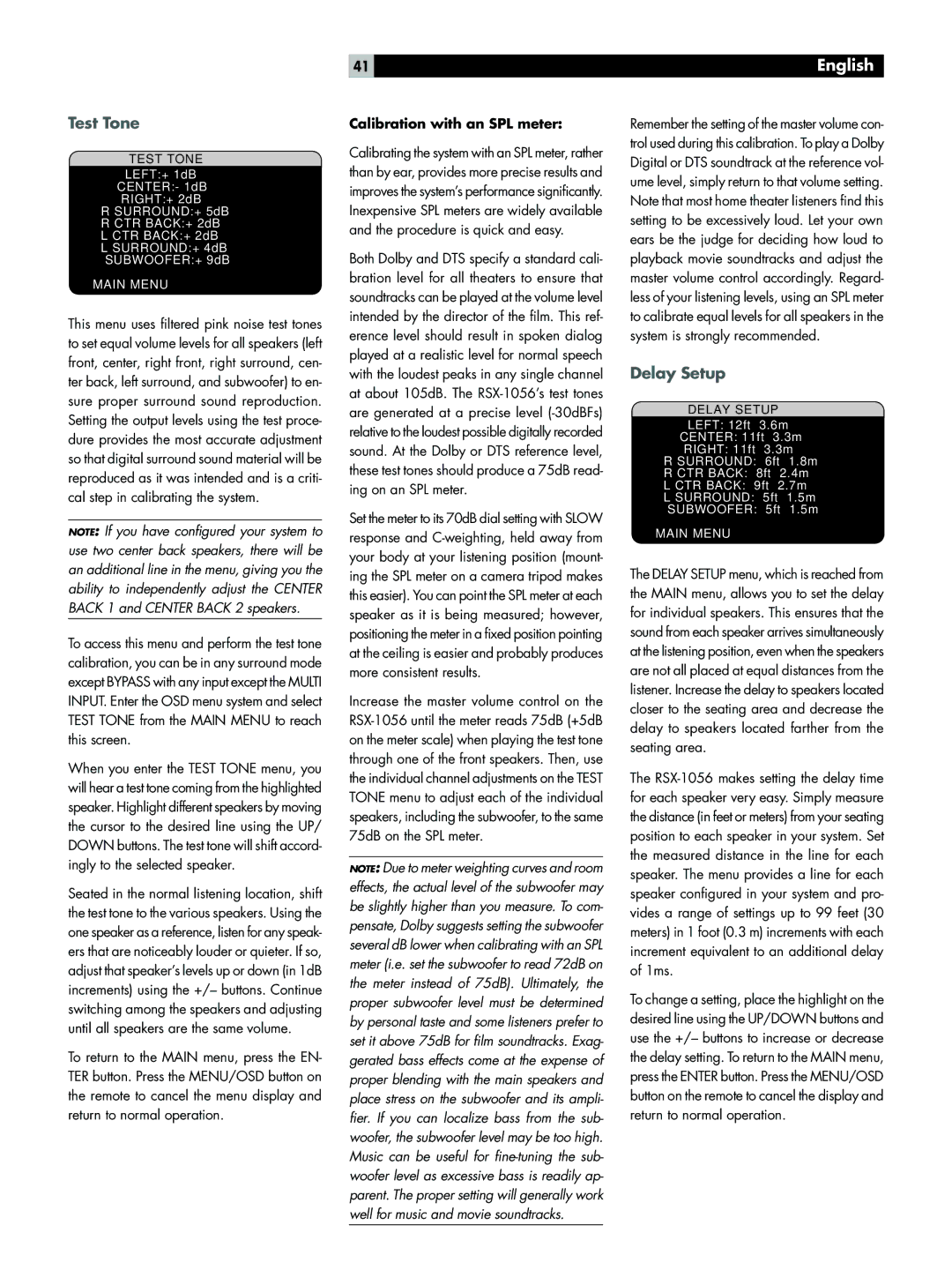
41 | English |
Test Tone
TEST TONE
LEFT:+ 1dB
CENTER:- 1dB
RIGHT:+ 2dB
R SURROUND:+ 5dB
R CTR BACK:+ 2dB
L CTR BACK:+ 2dB
L SURROUND:+ 4dB
SUBWOOFER:+ 9dB
MAIN MENU
This menu uses filtered pink noise test tones to set equal volume levels for all speakers (left front, center, right front, right surround, cen- ter back, left surround, and subwoofer) to en- sure proper surround sound reproduction. Setting the output levels using the test proce- dure provides the most accurate adjustment so that digital surround sound material will be reproduced as it was intended and is a criti- cal step in calibrating the system.
NOTE: If you have configured your system to use two center back speakers, there will be an additional line in the menu, giving you the ability to independently adjust the CENTER BACK 1 and CENTER BACK 2 speakers.
To access this menu and perform the test tone calibration, you can be in any surround mode except BYPASS with any input except the MULTI INPUT. Enter the OSD menu system and select TEST TONE from the MAIN MENU to reach this screen.
When you enter the TEST TONE menu, you will hear a test tone coming from the highlighted speaker. Highlight different speakers by moving the cursor to the desired line using the UP/ DOWN buttons. The test tone will shift accord- ingly to the selected speaker.
Seated in the normal listening location, shift the test tone to the various speakers. Using the one speaker as a reference, listen for any speak- ers that are noticeably louder or quieter. If so, adjust that speaker’s levels up or down (in 1dB increments) using the +/– buttons. Continue switching among the speakers and adjusting until all speakers are the same volume.
To return to the MAIN menu, press the EN- TER button. Press the MENU/OSD button on the remote to cancel the menu display and return to normal operation.
Calibration with an SPL meter:
Calibrating the system with an SPL meter, rather than by ear, provides more precise results and improves the system’s performance significantly. Inexpensive SPL meters are widely available and the procedure is quick and easy.
Both Dolby and DTS specify a standard cali- bration level for all theaters to ensure that soundtracks can be played at the volume level intended by the director of the film. This ref- erence level should result in spoken dialog played at a realistic level for normal speech with the loudest peaks in any single channel at about 105dB. The
Set the meter to its 70dB dial setting with SLOW response and
Increase the master volume control on the
NOTE: Due to meter weighting curves and room effects, the actual level of the subwoofer may be slightly higher than you measure. To com- pensate, Dolby suggests setting the subwoofer several dB lower when calibrating with an SPL meter (i.e. set the subwoofer to read 72dB on the meter instead of 75dB). Ultimately, the proper subwoofer level must be determined by personal taste and some listeners prefer to set it above 75dB for film soundtracks. Exag- gerated bass effects come at the expense of proper blending with the main speakers and place stress on the subwoofer and its ampli- fier. If you can localize bass from the sub- woofer, the subwoofer level may be too high. Music can be useful for
Remember the setting of the master volume con- trol used during this calibration. To play a Dolby Digital or DTS soundtrack at the reference vol- ume level, simply return to that volume setting. Note that most home theater listeners find this setting to be excessively loud. Let your own ears be the judge for deciding how loud to playback movie soundtracks and adjust the master volume control accordingly. Regard- less of your listening levels, using an SPL meter to calibrate equal levels for all speakers in the system is strongly recommended.
Delay Setup
DELAY SETUP
LEFT: 12ft 3.6m
CENTER: 11ft 3.3m
RIGHT: 11ft 3.3m
R SURROUND: 6ft 1.8m
R CTR BACK: 8ft 2.4m
L CTR BACK: 9ft 2.7m
L SURROUND: 5ft 1.5m
SUBWOOFER: 5ft 1.5m
MAIN MENU
The DELAY SETUP menu, which is reached from the MAIN menu, allows you to set the delay for individual speakers. This ensures that the sound from each speaker arrives simultaneously at the listening position, even when the speakers are not all placed at equal distances from the listener. Increase the delay to speakers located closer to the seating area and decrease the delay to speakers located farther from the seating area.
The
To change a setting, place the highlight on the desired line using the UP/DOWN buttons and use the +/– buttons to increase or decrease the delay setting. To return to the MAIN menu, press the ENTER button. Press the MENU/OSD button on the remote to cancel the display and return to normal operation.
